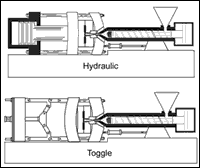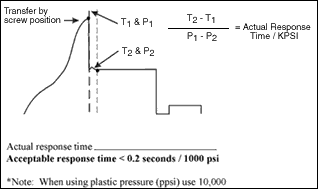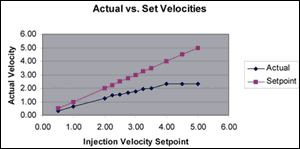Has the Molding Machine Been Tested?
Knowing how a machine is tuned will improve your decision making for mold construction and adjustments.
You’ve just purchased a new mold and it will not fill properly, even though you’ve tried several injection speeds to get the plastic in the mold. When the mold was sampled by the mold builder, they only needed one injection speed. But now that the mold is at your facility the runner design is not right, it seems like it needs to be bigger.
You finally get the mold to fill with a new bag of virgin material; but as soon as you start another bag of material you have trouble filling the mold. You determine that material must be bad, so you try another bag and things seem to be acceptable now.
After filling the cavity to 95 percent you struggle with getting the part packed out, you keep raising the pack pressure and adding more time. Now you are not making the required cycle time, the parts are dimensionally incorrect, the gate is incorrect and you think you must have used the wrong shrink value for that material.
This is just a very small sample of problems molders face every day in our industry. The problem is how do you truly know if the mold needs adjusting, or if the molding machine is not performing up to par, or doesn’t meet the requirements of the mold, or needs a tune up? In the scenario of the first paragraph, how do you know that the runner needs adjusting, or possibly the molding machine needs an injection speed linearity test done to validate that the machine is capable of moving at the required speed?
This article will discuss machine attributes that can cause an inability to process as well as how to recognize these conditions and know if the adjustments we make to the mold are valid, or just band aids for shortcomings of the molding machine? Most moldmakers never perform mold tryouts, although they are an important part of reaching the cycle time goals and consistent quality for the molder. Maybe for the moldmaker, just having a copy of these tests for the molding machine that the mold will be run in, will allow them to move up to the next level of producing higher quality molds with more successful tryouts.
In “Rigorous Mold Tryout: Do your Homework”, we discussed the most basic concerns of choosing the right molding machine based on cavitation, shot size and clamp force. We will not delve into those topics again, though it would be beneficial to reference that article before implementing a machine testing program.
Speed Linearity
Injection speed has a very large effect on viscosity. Simply enlarging the runner will only raise the viscosity due to a volumetric change, as the hole gets bigger the flow of plastic slows down, which could further complicate the problem. For example, a struggling processor asked for help to get a process started. The mold would not fill properly; so it was immediately stopped and the linearity was checked. It was found that the machine was incapable of achieving the fastest speeds. After a few phone calls, it was discovered that this machine had been tuned to run a type of PVC that required the machine to be tuned at a slower speed. For that application the machine did well; however, due to this tuning, the machine was not the best choice for the Nylon that was trying to be used for the current job. Prior to discovering the inadequacy of the machine speed control, the operator, mold and material had all been blamed at one time or another.
To perform an injection speed linearity test turn off pack, hold time, pressure and velocity and then establish an 80 percent filled part at the fastest injection speed. Note: some machines carry a residual pressure and or time, so it is recommended that you turn them off or at least to their minimum value. Now set the injection speed near or at the lowest speed and note the fill time. Calculate the correct fill time and compare the numbers. To do this, take the shot size minus transfer and divide by the speed and compare the actual to the calculated. Now continue doubling the speed and record the actual fill time, comparing it to the new calculated fill times. Note: each time you change speeds you must recalculate the new fill time for your comparison. The goal is to have a range of 10 percent or less. If this is attainable, the machine has very robust injection tuning and you should adjust the runner, not by enlarging it, but by making it smaller to reduce the viscosity due to the volumetric flow rate change and possibly lower the pressure loss due to the plug flow. An example speed linearity test is shown in Figure 1.
Material
Earlier in this article we immediately blamed the material for the process changing when a new bag of material was introduced. How do we know that this is the case? It is possible the machine is load sensitive or sensitive to load change via a viscosity shift in the material. To measure this function we need to make a shot in the mold and record the fill time and peak pressure at transfer, this is done with pack and hold off during the production of the short shot. Next move the injection unit back and install a purge plate, then make the same shot in the air using semi auto or auto mode from the molding machine. Note: if manual is used on some machines, you will use a low volume pump—causing a discrepancy in the data (see Figure 2).
The third paragraph talks about the fact that packing the part out on this machine is a concern that may not be related to the mold. The problem could be the valves (hydraulic dynamics) or the function of communication to the valves (or the ball and screw movement for electric machines) in the molding machine. You need to measure the machine's ability to shift from a velocity setting to a pressure over time request, as this needs to be very good. Why? Because it may take the machine a half to a full second to settle into the pressure that you have requested and in some cases pack may only be one second in a five- to 10-second cycle time. This is most critical for packing the last 3 to 5 percent of the material into the cavity, as the plastic is starting to solidify and you don’t have the control necessary to support this type of processing if this exists. By understanding this test your decisions will be better supported when deciding if the material is the problem or not. A machine that can repeat hold pressure and back pressure settings also is an important measurement of good performance from the machine (see Figure 3).
Platen Deflection
Another area of concern is platen deflection. If you under-stand the amount of platen deflection, a calculated decision can be made early about the mold base construction. For example, if the machine the processor will be using has a problem with platen deflection, you could increase the size of the mold base to cover more of the platen, or use thicker plates to help support the load. You must take into account the different machines to be used if this mold will produce parts in multiple machines. You also must know whether a toggle or hydraulic machine is used as platen deflection is very different between the two (see Figure 4).
The demand for faster cycle times will continue to increase, as will quality requirements. Knowing how a machine is tuned will improve your decision making for mold construction and adjustments, enabling you to fine tune the decision making process to better achieve the goals of the future and keep you from applying Band-Aids where they should not be. The best case scenario for all would be no Band-Aids at all.
Related Content
What is Driving Mold Lifecycle Management Digitalization?
OEMs are looking to partner with suppliers to share and track data across the supply chain for advanced intervention and process management.
Read MoreTackling a Mold Designer Shortage
Survey findings reveal a shortage of skilled mold designers and engineers in the moldmaking community, calling for intervention through educational programs and exploration of training alternatives while seeking input from those who have addressed the issue successfully.
Read MoreMMT Chats: Solving Schedule and Capacity Challenges With ERP
For this MMT Chat, my guests hail from Omega Tool of Menomonee Falls, Wisconsin, who share their journey with using enterprise resource planning (ERP)—and their people—to solve their schedule and capacity load monitoring challenges.
Read MoreThink Safety: Eliminate Hazards Throughout the Shop
The tooling community is taking advantage of new products for safer mold shops and molding facilities.
Read MoreRead Next
Setting Up a Robust Process Forever
Deciding how to process a product with the least amount of part variation over the long term.
Read MoreHow to Use Continuing Education to Remain Competitive in Moldmaking
Continued training helps moldmakers make tooling decisions and properly use the latest cutting tool to efficiently machine high-quality molds.
Read MoreAre You a Moldmaker Considering 3D Printing? Consider the 3D Printing Workshop at NPE2024
Presentations will cover 3D printing for mold tooling, material innovation, product development, bridge production and full-scale, high-volume additive manufacturing.
Read More





















